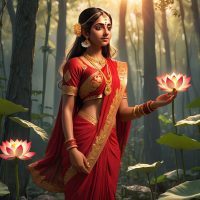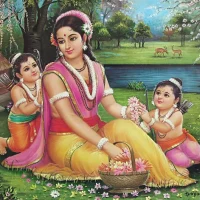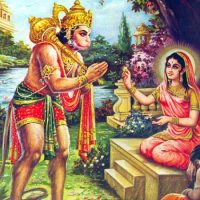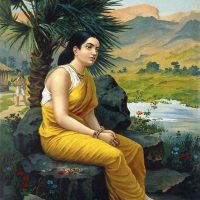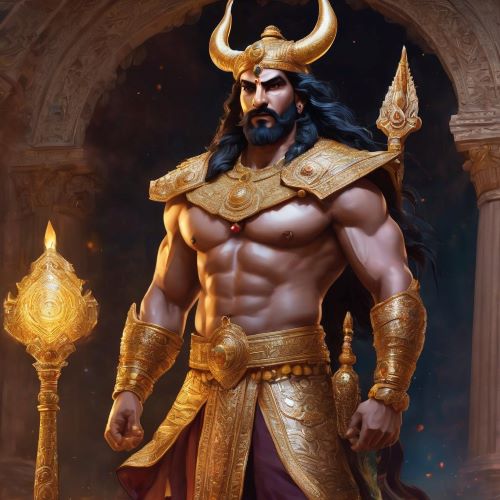Sita : The Dutiful Wife
Listen
At a glance
| Description | |
|---|---|
| Origin | Indian Mythology |
| Classification | Mortals |
| Family Members | Bhumi (Mother), Rama (Husband), Lava and Kusha (Children) |
| Region | India |
| Associated With | Duty, Mental Strength |
Sita
Introduction
Sita, the beloved heroine of the Ramayana, stands as one of the most revered figures in Hindu mythology. Worshipped as the goddess of purity, strength, and devotion, she represents the ideal balance between compassion and courage. Considered an incarnation of Goddess Lakshmi, Sita symbolizes divine grace and the eternal power of righteousness. Her story, filled with sacrifice, endurance, and faith, reflects the essence of dharma, or moral order, that governs the universe.
Her name comes from the Sanskrit word sīta, which means “furrow,” a reference to her miraculous birth from the Earth while King Janaka plowed a sacred field. Sita’s life is not merely the tale of Rama’s wife but a journey of her own—one that speaks of perseverance, purity, and independence. Through her trials and triumphs, she became a symbol of virtue, moral strength, and unwavering faith in truth.
Physical Traits
Sita is described as extraordinarily beautiful, with features that radiate serenity and divine energy. Ancient texts refer to her as “Kanakavarnaangi,” meaning she has a golden complexion that glows with inner purity. Her eyes are compared to lotus petals, reflecting compassion and calmness. Her long, dark hair, often described as shining like a monsoon cloud, frames her gentle and dignified face.
Valmiki’s Ramayana and later texts portray her as a woman of perfect proportion and grace. Her voice is said to be as sweet as the sound of a veena, and her smile carries an aura of peace. In paintings and sculptures, Sita is often shown wearing red or yellow garments, representing fertility, prosperity, and auspiciousness. Her beauty is not portrayed as superficial but as an outward reflection of her inner strength and virtue.
Family
Sita’s origins are both mysterious and divine. King Janaka of Mithila found her in a furrow while performing a ritual plowing of the earth, symbolizing her connection to Mother Earth herself. He and his wife, Queen Sunaina, adopted her and raised her as their own daughter. Because of this miraculous birth, Sita is often called Bhumija, meaning “daughter of the Earth.”
As the princess of Mithila, Sita grew up in a household that valued virtue, wisdom, and devotion. She later married Prince Rama of Ayodhya, who is regarded as an avatar of Lord Vishnu. Their marriage was the result of Rama stringing and breaking the great bow of Shiva during her swayamvara, a contest set by her father to find her a worthy husband.
Sita’s sisters also shared deep ties with Rama’s family. Her sister Urmila married Lakshmana, while her cousins Mandavi and Shrutakirti married Bharata and Shatrughna. Sita and Rama had twin sons, Lava and Kusha, who were born during her exile and raised under the guidance of Sage Valmiki. The boys later reunited their parents by reciting the story of the Ramayana, ensuring that Sita’s legacy would live forever.
Other names
Throughout history, Sita has been known by many names that reflect different aspects of her identity. The name “Sita” signifies her miraculous birth from the furrow of the Earth. “Janaki” identifies her as the daughter of King Janaka, while “Maithili” refers to her royal lineage as the princess of Mithila. “Vaidehi” connects her to the kingdom of Videha, another title of her father.
She is also called “Bhumija,” meaning the daughter of the Earth Goddess, and “Ramā,” acknowledging her role as the consort of Lord Rama. In devotional traditions across India, she is affectionately addressed as “Siya” or “Seetha Devi.” Each name carries a spiritual or regional nuance, but all honor her as a goddess who embodies love, compassion, and steadfast virtue.
Powers and Abilities
Sita’s power lies not in physical strength but in her moral and spiritual force. As an incarnation of Goddess Lakshmi, she embodies divine feminine energy, or shakti. This energy sustains creation and represents balance, compassion, and endurance. Her purity is her greatest strength, making her untouchable even in adversity.
During her captivity in Lanka, Sita resisted Ravana’s temptations with unshakable faith and self-control. She declared that her inner purity alone could destroy him if she chose, but she remained committed to her dharma, waiting for Rama to fulfill his duty as a warrior. This spiritual discipline is a reflection of her extraordinary power of restraint and devotion.
Her trial by fire, known as Agni Pariksha, further demonstrated her divine nature. Emerging unscathed, she proved that truth and virtue could never be destroyed. Even Agni, the fire god himself, recognized her sanctity and refused to harm her.
Sita’s connection with the Earth is another expression of her divine energy. Nature responds to her emotions, and her final act of returning to the Earth at the end of her life represents both liberation and reunion with her source. Her choice to return to the ground is often interpreted as a powerful assertion of self-determination and dignity, marking her as a woman who defined her destiny on her own terms.
Modern Day Influence
Sita’s influence continues to shape Indian culture, religion, and art in profound ways. Her story remains central to the Ramayana, one of the most widely read and performed epics in Asia. Across India and neighboring countries like Nepal, Thailand, and Indonesia, Sita is worshipped as a goddess of virtue and strength. Festivals such as Sita Navami and Vivaha Panchami celebrate her birth and marriage, keeping her memory alive in popular devotion.
In modern times, Sita has also become a symbol of female strength and resilience. Writers, artists, and filmmakers have reinterpreted her story to reflect contemporary values and questions about gender and morality. Chitra Banerjee Divakaruni’s The Forest of Enchantments gives Sita her own voice, portraying her as a woman of agency and intelligence rather than a passive figure. Devdutt Pattanaik’s Sita: An Illustrated Retelling of the Ramayana explores her story through the lens of dharma and equality. Amish Tripathi’s Sita: Warrior of Mithila reimagines her as a strategist and protector, emphasizing her independence and leadership.
In visual culture, Sita continues to inspire new forms of storytelling. The graphic novel Sita’s Ramayana by Samhita Arni and Moyna Chitrakar presents her perspective on the war, while the animated film Sita Sings the Blues by Nina Paley uses her story to explore themes of love, loss, and autonomy. These interpretations present Sita not only as an icon of virtue but also as a timeless figure of empowerment.
Beyond art and literature, Sita’s symbolism extends to modern social and environmental movements. Her bond with the Earth connects her to ecological awareness, while her commitment to truth and justice serves as a moral guide for people seeking balance and integrity in modern life. Sita remains a bridge between tradition and progress, embodying values that transcend time and culture.
Related Images
Source
Bhūmi, V. (2022, November 6). Sita: Hindu goddess of courage, purity, and sacred femininity. Exotic India Art. https://www.exoticindiaart.com/blog/maa-sita/
Britannica. (2025, October 5). Sita | Ramayana, Avatar, Exile. https://www.britannica.com/topic/Sita
Hindu American Foundation. (2021, May 16). All about Devi Sita. https://www.hinduamerican.org/blog/devi-sita/
Poojn.in. (2025, May 9). Sita’s family and lineage: A complete explanation. https://www.poojn.in/post/30582/sitas-family-and-lineage-a-complete-explanation
Poojn.in. (2025, May 9). Sita’s physical characteristics: Descriptions from Valmiki’s Ramayana. https://www.poojn.in/post/30573/sitas-physical-characteristics-descriptions-from-valmikis-ramayana
Poojn.in. (2025, May 9). Sita in popular culture: A 2025 perspective on her everlasting influence. https://www.poojn.in/post/30570/sita-in-popular-culture-a-2025-perspective-on-her-everlasting-influence
Valmiki, & R. Goldman (Trans.). (1991). The Ramayana of Valmiki: An epic of ancient India (Princeton University Press).
Yoga Anytime. (2022, April 6). Sita’s story: The grounding support of mother earth. https://www.yogaanytime.com/blog/philosophy/sitas-story-the-grounding-support-of-mother-earth
Valmiki. (c. 500 BCE). Ramayana (Various translations).
Pattanaik, D. (2013). Sita: An Illustrated Retelling of the Ramayana. Penguin Books.
Tripathi, A. (2017). Sita: Warrior of Mithila. Westland Publications.
Doniger, W. (2009). The Hindus: An Alternative History. Penguin Press.
Richman, P. (Ed.). (2001). Many Ramayanas: The Diversity of a Narrative Tradition in South Asia. University of California Press.
Frequently Asked Questions
What is lorem Ipsum?
I am text block. Click edit button to change this text. Lorem ipsum dolor sit amet, consectetur adipiscing elit. Ut elit tellus, luctus nec ullamcorper mattis, pulvinar dapibus leo.
What is lorem Ipsum?
I am text block. Click edit button to change this text. Lorem ipsum dolor sit amet, consectetur adipiscing elit. Ut elit tellus, luctus nec ullamcorper mattis, pulvinar dapibus leo.
What is lorem Ipsum?
I am text block. Click edit button to change this text. Lorem ipsum dolor sit amet, consectetur adipiscing elit. Ut elit tellus, luctus nec ullamcorper mattis, pulvinar dapibus leo.
What is lorem Ipsum?
I am text block. Click edit button to change this text. Lorem ipsum dolor sit amet, consectetur adipiscing elit. Ut elit tellus, luctus nec ullamcorper mattis, pulvinar dapibus leo.
What is lorem Ipsum?
I am text block. Click edit button to change this text. Lorem ipsum dolor sit amet, consectetur adipiscing elit. Ut elit tellus, luctus nec ullamcorper mattis, pulvinar dapibus leo.


